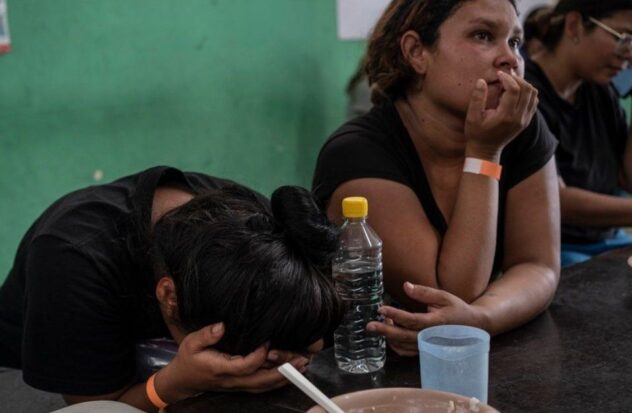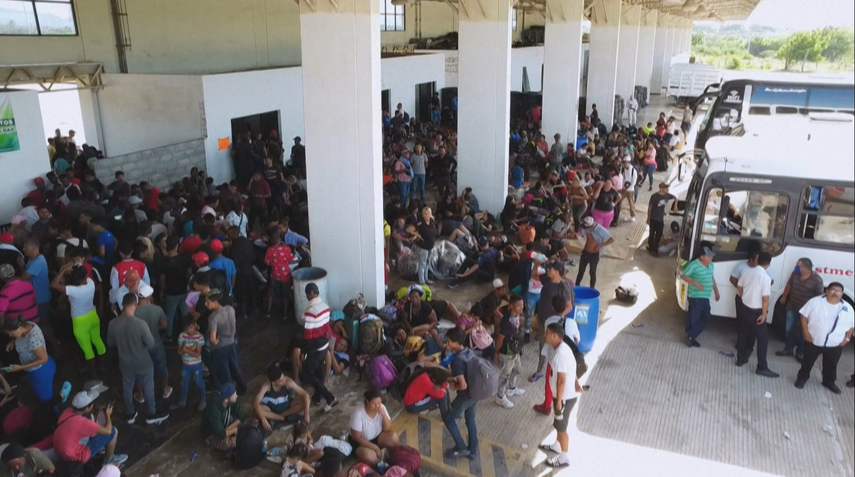Since he left Venezuela last January to escape the crisis, the 23-year-old went through the Darien Gap -the jungle that divides Colombia and Panama-, was almost kidnapped by a Mexican cartel and waited for months to get an appointment to request asylum in USAwhich never arrived.
She finally crossed the border in May, only to be expelled by US authorities shortly thereafter.
Now he’s back in the South of Mexico after Mexican immigration authorities took her by bus to the city of Villahermosa and left her on the street.
“I would rather cross the Darien Gap 10,000 times than cross Mexico,” said García, sitting in a migrant shelter, referring to the Darien Gap by its English name.
The young woman was clinging to a crumpled transparent plastic bag that contained her Venezuelan identification document, an inhaler and an apple, the few belongings she had left.
Migrants in limbo
Driven by growing pressure from the United States to prevent the passage of millions of vulnerable people heading north, but without the funds to deport them, Mexican authorities employ a tactic that is as simple as it is harsh: wear down migrants until they give up.
This means that migrants remain in limbo while they are detained by authorities in different parts of the country and left to fend for themselves in the cities of Villahermosa and Tapachula, in southern Mexico. Some have been sent back up to six times.
He Mexican president, Andrés Manuel López Obrador, He said Monday that this policy protects migrants.
“We care a lot about keeping migrants… in the southeast because the journey north is very risky,” López Obrador said during his daily news conference.
But the transfers have forced migrants, including pregnant women and children, into even more precarious situations. And conditions are likely to get worse now that the president Joe Biden approved new restrictions on asylumanalysts say.
The measures implemented by Mexico explain why the number of migrants at the US-Mexico border fell 40% from its all-time high last December and remained unchanged throughout the spring. This coincided with an increase in the number of migrants who are in Mexico without legal authorization, data from the National Migration Institute shows.
U.S. authorities largely attribute the success to the vigilance of their Mexican counterparts at rail yards and highway checkpoints.
“Mexico is the wall”
“Mexico is the wall,” said Josué Martínez, a psychologist at Villahermosa’s only migrant shelter, the Oasis of Peace of the Holy Spirit Amparito, which was preparing for an avalanche of people under the Biden’s move to halt asylum procedures once US authorities consider that the southern border is overflowing.
The small shelter has been in trouble since the Mexican government began restricting migrants two years ago. Last month it housed 528 people, up from 85 in May 2022.
“What are we going to do when larger quantities arrive?” Martínez said. “Every time the United States issues a statement to reinforce containment measures on the northern border, it is automatic. We know that people are going to come to Villahermosa… there is going to come a point where we are going to collapse,” he warned.
From Villahermosa, migrants walk or take buses north to Mexico City, where they can request an appointment to request asylum from U.S. authorities through the U.S. Customs and Border Protection application. United States (CBP), CBP One. But most never get close enough to the border for the app to detect their location.
Checkpoints dot the roads in southern Mexico. Armed soldiers take migrants off buses and detain those walking on the surrounding roads and mountains. Immigrants report that they are extorted by members of law enforcement or Mexican immigration officials in order to continue their trip. After disbursing large sums of money on two or three occasions, the families were left with nothing. They were later taken by bus to the south of the country, where most ended up staying on the streets.
Nothing humanitarian
Mexican authorities refer to temporary detentions as “humanitarian rescues.”
But Venezuelan Keilly Bolaños assures that these operations have nothing humanitarian. She and her four children have been transferred to southern Mexico six times. This 25-year-old single mother seeks asylum so that her 4-year-old daughter can receive treatment for leukemia, to which she does not have access in Venezuela.
She was detained a few days ago in the border state of Chihuahua, where she says soldiers beat her in front of her children and then placed them on a bus for a two-day trip to Villahermosa.
“How can you run when you have four kids? “You can’t,” Bolaños said.
The family slept in cardboard boxes with other immigrants outside the Villahermosa bus terminal. Bolaños still had bruises on his legs. However, he planned to head north for the seventh time. He has nowhere to go.
“I know this effort will be worth it one day,” he added.
Hot cloths
Mexico’s tactics appear a way to reassure the United States, which has pressured Latin American countries to help curb migration even though it has failed to enact reforms to its own immigration system.which most Americans agree doesn’t work.
He Incoming president of Panama vowed to block passage through the Darien Gap, while Biden softened criticism against the president of El Salvador after he reduced migration.
When Biden announced his new restrictions last week, he said he had “drastically” reduced the arrival of migrants at the border. “due to the agreement I have reached with President (López) Obrador”. She stated that he also plans to work on border issues with the next president, Claudia Sheinbaum.
But Michael Shiftersenior researcher at the Inter-American Dialogue, noted that such measures are only a short-term solution that does not address the root causes of migration.
“They say this is a regional challenge that we all have to face together, which is true,” Shifter explained. “The problem is: if the United States cannot put its own house in order, that sends a message to other governments that ask: Why should we work with them if the United States itself is not capable of addressing the problem?” he posed.
Migrants ask for help
Some asylum seekers said they were ready to give up their “American dream” but cannot leave the country because they do not have access to a consulate or have run out of money.
After being removed from a bus, a group of migrants pleaded with authorities to help them return to Venezuela shortly before being sent back to southern Mexico.
“We just want to go to the embassy in Mexico City to go to Venezuela,” Fabiana Bellizar, 30, told agents after she was sent back from northern Mexico the day before. “We don’t want to be here anymore.”
They began the same journey the next day.
Others said they would try to find work and a place to sleep in the city before continuing.
López Obrador declared Monday that migrants are offered jobs in the south, but the lucky few who find employment face precarious conditions. One migrant was paid $25 a day for 12 hours of work under the scorching sun in a mango orchard. Another said employers tried to force her into prostitution.
Others are forced to take more dangerous routes, and fall into the arms of organized crime groups seeking to kidnap immigrants.
As soon as he saw flashing lights in the distance, Honduran Alexander Amador, 27, hid behind a tree to hide in the shadows on the side of the highway between the states of Veracruz and Tabasco.
Amador and his two traveling companions had walked for 10 hours, entering the jungle to escape the authorities who were trying to stop them on the road. After being returned to southern Mexico twice while traveling by bus, it was the only thing the Hondurans could think of to move forward.
But they were afraid, both of the Mexican security forces and of the cartels. Security in the southern states of Tabasco and Chiapas has plummeted in the last year as cartels battle for control of lucrative migration routes.
“You can’t trust anyone here. “Everything is a danger,” stated Amador, as he shouldered his backpack and walked into the darkness.
Source: With information from AP



